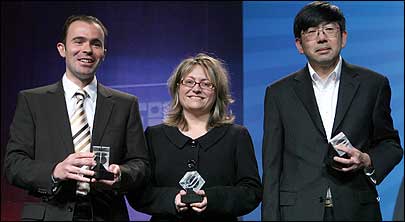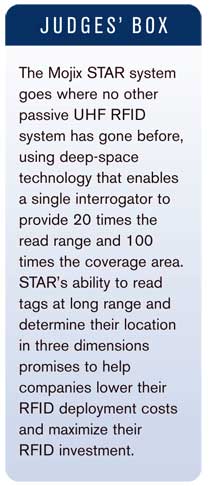Jun 18, 2008Award Winner: Best in Show
June 1, 2008—On April 18, RFID Journal presented the second annual RFID Journal Awards to three companies for outstanding achievement in radio frequency identification technology at RFID Journal LIVE! 2008, our sixth annual conference and exhibition.

The award winners are:
• Airbus for best RFID implementation
• InterfaceFlor for most innovative use of RFID
• Agence métropolitaine de transport for best use of RFID in a service
You can read about each company's RFID project—and see why the company is being honored—in the case studies linked to the above company names. Each story is unique, highlighting the many ways RFID can be implemented, and each shows how RFID can be used profitably today.
In addition, Mojix took the award for the best new RFID product. The Mojix STAR (Space Time Array Reader) system—which we introduced in an exclusive story in the March/April 2008 issue while the company was still in stealth mode (see Product Developments)—was demonstrated at RFID Journal LIVE! and more details were revealed. In addition, end users who have tested the system say STAR lives up to its potential.
STAR shined as it interrogated EPC Gen 2 passive ultrahigh-frequency tags from across the exhibit hall—a distance of about 300 feet, in a room full of RF energy from exhibitors demonstrating products.
Perhaps most important, the STAR system allows end users to identify tagged items in three-dimensional space. That means retailers or manufacturers could map a tagged item to a specific location and quickly find it, even if it's on the wrong shelf in a store or rack in a warehouse.
Procter & Gamble, which has been testing the Mojix system for more than a year at its RFID test lab, says a single interrogator can read tags moving through 49 dock doors, as well as tags outside the lab and others mounted on RF-unfriendly metal racks. Kraft Foods, which deployed STAR at a warehouse in Germany from which it ships RFID-tagged product headed for German retailer Metro, achieved similar results.
"We're very pleased with the results," says Mark Pollock, Kraft's director of customer development for integrated store logistics. "The possibilities for using the Mojix technology are limitless in a large warehouse."
"This is a breakthrough," says Ramin Sadr, Mojix's founder and CEO. "It renders all applications in the supply chain more economical."

